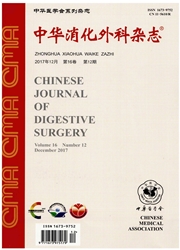

 中文摘要:
中文摘要:
胃肠道间质瘤(GISTs)是一种起源于胃肠道间质干细胞的消化道间叶性肿瘤,由未分化或多能的梭形上皮样细胞组成,可发生于胃肠道全长范围,并偶见于网膜、肠系膜等消化道以外的部位.因GISTs具有广谱的生物学行为,其治疗存在较大困难.外科手术是原发性GISTs唯一可能治愈的手段,但术后存在复发风险.然而,什么样的患者需要接受外科手术,什么样的患者需要接受伊马替尼的治疗,复发的风险怎样评估,目前还没有理想的评价标准.无论是常用的F/NIH共识、美国武装部队病理研究所(AFIP)标准、改良的美国国立卫生研究院(NIH)标准,还是数学模型共识,均无法准确评估复发风险的概率.因此,GISTs术后复发风险评估成为了当前研究的重点.近年来,有学者用列线图预测GISTs术后复发风险,并取得了一定的成果.
 英文摘要:
英文摘要:
Gastrointestinal stromal tumor (GIST) is originated from the gastrointestinal mesenchymal stem cells,composed of undifferentiated or pluripotent spindle and epithelioid cells,often occurs in the whole range of the gastrointestinal tract and occasionally in the omentum,mesenterium and other areas which are outside of digestive tract.The treatment is difficult due to broad-spectrum biological behaviour of GIST,while surgery may be the only potential method for curing GIST with a risk of recurrence.Currently,there is still not an evaluative standard in the choice of surgery or imatinib therapy as well as the risk of recurrence.The F/NIH consensus,Armed Forces Institute of Pathology (AFIP) standard,modified standard of National Institutes of Health(NIH) and consensus of mathematical model which have been widely used cannot accurately evaluate risk probability of recurrence,so the current researches have focused on the postoperative risk assessment for GIST.In recent years,the nomogram model has been applied to predict the risk of GIST recurrence by some scholars,with the better outcomes.
 同期刊论文项目
同期刊论文项目
 同项目期刊论文
同项目期刊论文
 期刊信息
期刊信息
